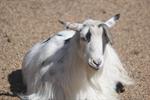 The goat is a member of the family Bovidae. The goat specifically belongs to the subfamily Caprinae and is closely related to the sheep.
The goat is a member of the family Bovidae. The goat specifically belongs to the subfamily Caprinae and is closely related to the sheep.
Goats are categorized as an herbivorous mammal and are one of the oldest domesticated species.
Neolithic farmers are known to have herded wild goats to provide them with milk and meat and also bone, sinew and hair for making tools, clothes and building.
The first area of captivity is known to be in the South-East Asia region about 8000BC. Before this time, goats were only known to be feral
Uses for Goat & Goat Products
Domestic goats are one of the most useful animals to have as they are easy to look after and feed.
As a domestic farm animal they can be used to produce a variety of products, such as:
- Dairy (milk, butter, yoghurt)
- Meat
- Leather
- Wool (fleece goats)
- Soaps, body and hair care products
In Europe and North America, intensive, high-yielding dairy goat herds are common. In Afghanistan cashmere goats are kept on rangelands for their meat and fleeces. In Africa, subsistence farmers commonly keep dual-purpose goats on their smallholdings for milk and meat. In Australia, goats are farmed and exported for meat in large volumes. Feral goats are commonly run alongside sheep and beef herds in New Zealand to help manage weeds and scrub in pasture. In the 1900’s goats have become very popular as pets, more commonly in Europe and North America.
Goat Breeds
Nowadays, there are over 300 different breeds of goats. Goat breeds fall into a number of general categories. They are generally classified by their main use e.g. dairy, meat, fibre/fleece or companion animals.
Dairy goats may be of 4 different breeds:
- Saanen
- Toggenburg
- British Alpine
- Anglo-Nubian
Examples of specific meat breeds:
- Spanish meat goat
- South African Boer
- New Zealand Kiko
Examples of specific fibre/fleece goats
 Examples of companion goat breeds
Examples of companion goat breeds
There are also many cross breeds, including crosses between dairy goats and fleece goats.
Working with Animals Takes Real Commitment - Is this the right course for you?
So before deciding if you want to work in a particular job, you should consider:
- Are you more comfortable being with people, with animals, or alone (perhaps with a computer)?
- Are you good with live animals?
- Do you like physical activity?
- Do you prefer being outside or inside?
- Are you good with biological science?
- Do you enjoy being with animals?
- Do you enjoy being with people who like animals?
- Are you uncomfortable standing in front of a group of people?
- Are you able to talk to strangers or do you prefer working with people you know?
- Do you prefer working one to one with people?
- Do you like working in a group situation?
- Do you like helping other people to learn and change?
- Do you like giving people knowledge?
- Do you like helping people to solve problems?
If you have a passion for herd animals, work with them, of for some other reason, need to learn more about them, this course is for you.
This course is suitable for anyone who is caring for or raising
goats, or wants to learn more about it. You do not require any prior
knowledge to study the course, just an enthusiasm and interest in goat
keeping.
This course will also be useful to anyone who wants to improve their
job and career prospects in agriculture and animal care, such as -
- farm workers
- rescue workers
- people working in urban farms
- people working in parks
- those working in petting zoos
- passionate amateur zoologist or conservationist
- volunteer or employee in a wildlife park, zoo or animal refuge
- student or researcher of biology, zoology or wildlife management
- veterinary or animal science professional
- agriculture student or establised farmer
- small holding or hobby farmer seeking to develop skills in yourself or your staff.
Study this course if you want -
- detailed knowledge and insight into caring for goats
- a useful addition to your CV
Any Questions?
